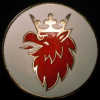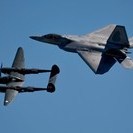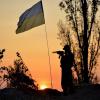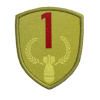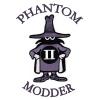Leaderboard
Popular Content
Showing most liked content on 09/28/2023 in Posts
-
7 pointsGetting off the deck is the easy part. There's always a critic in the audience waiting to blow up your performance.... I had some operator control issues on the landing.... Kinda drifted on the touchdown Talk about getting it stopped at the Last Second......
-
5 pointsGloster Gale F.Mk.I - No.258 Squadron, Tiger Force, RAF Pacific Air Command, 1945 The Air Ministry Specification F.5/34 (which would eventually lead to the Hawker Hurricane and Supermarine Spitfire) was an ambitious request for a single-seat monoplane interceptor fighter with an enclosed cockpit and retractable main landing gear plus the then heavy armament of at least six and preferably eight .303 inch Browning machine guns with 300 rounds per gun. The response by the Gloster Aircraft Company was never officially named and was simply referred to as the Gloster F.5/34 but it was a modern monoplane of monocoque construction with a Duralumin stressed-skin fuselage, wings and tail and a fabric covered rudder, ailerons and elevators. The armament of eight Browning machine guns was mounted in the wings outside of the propeller disc and power for the F.5/34 was provided by a Bristol Mercury IX nine-cylinder radial engine rated at 840 hp neatly enclosed in a streamlined cowling and turning a three-bladed de Havilland controllable-pitch propellor. However, the design team at Gloster's were deeply involved with the development and production of the Gauntlet and Gladiator and progress was on the F.5/34 was so slow that the first prototype would not take to the air until December 1937 by which time the Hurricane was just entering service with the RAF and the Spitfire was in production too. The second prototype followed quickly enough and whilst the two F.5/34 prototypes displayed good all-round handling characteristics unfortunately no production order was received. The Air Ministry encouraged Gloster to respond to Specification F.18/37 for a fighter which would be able to achieve at least 400 mph at 15,000 feet with an even heavier armament of twelve Browning machine guns with 500 rounds per gun and a service ceiling of 35,000 feet. This was a tough requirement to meet but it was made even harder by the Air Ministry (perhaps already forecasting a shortage of Rolls-Royce Merlin engines) instructing Gloster to use the Bristol Hercules II supercharged radial engine with a projected power output of 1,375 hp that was significantly lower than the 1,760 hp of the Rolls-Royce Vulture 24 cylinder liquid-cooled piston engine planned for the Hawker Tornado. The Gloster design team realised that they were unlikely to meet the speed and armament requirements of Specification F.18/37 on the projected power output of the Hercules II engine so politely declined to tender but continued to refine their F.5/34 design as a private venture. Allocated the project number P.177 the Gloster design team became focused on accommodating the larger Hercules engine whilst retaining it's relatively small airframe and paid particular attention to keeping weight as low as possible. Armament was reduced to just four guns consisting of two fuselage-mounted, synchronized .50 inch AN/M2 Browning machine guns firing through the four-bladed Rotol propeller and two wing-mounted 20mm Hispano II cannon. The wing of the new P.177 was made slightly shorter when compared to the F.5/34 but Gloster were able to use an improved NACA 63-215 airfoil shape with a reduced thickness to chord ratio and also switched to a fully-enclosed inwards retracting main landing gear. Whilst the empty weight had increased considerably the actual power to mass ratio had increased from 0.20 hp/lb to 0.25 hp/lb and the beautifully cowled Hercules engine and longer airframe promised lower drag due to the improved fineness ratio. As part of the Hawker Aircraft Group, Gloster's were again bogged down with production of Hurricanes and Typhoons and were further side-tracked when a large part of the design team were split off to focus on the E.28/39 'Gloster-Whittle' jet and the F.9/40 jet fighter based on a far-sighted brochure submission dating back to August 1940. However, the small P.177 project team continued to make progress and on August 18th,1941 a contract was issued by the Air Ministry for "two P.177 prototypes with Hercules VI radial engines" a move motivated by combat reports from the Middle East and North Africa that clearly showed the performance degradation of the RAF's Hurricanes and Spitfires when fitted with the Vokes air filter. With the move from project to prototype, the Gloster board approved the name of Gloster Gale which fitted in with the naming convention of the parent company Hawker Aircraft Group (e.g. Hurricane, Tornado, Typhoon and Tempest). The prototype Gloster Gale (HV268) was powered by the Hercules VI which delivered 1,650 hp and made it's maiden flight from Hucclecote on May 2nd, 1942 flown by Michael Daunt who reported it to be "a pleasant and manoeuvrable aircraft with no major handling faults". The second prototype (HV269) was much more representative of an operational aircraft with various of items of service equipment including armament and the Type I Mk.III reflector gunsight. During the summer and Autumn of 1942 both prototypes were flown by test pilots from Gloster and RAF pilots and it was clear that the Gale was a thoroughly competent fighter aircraft but did not offer any real advantages over the RAF's frontline fighters in Europe. However, the Air Ministry believed that it could be of use overseas and awarded Gloster's a production contract for 300 Gloster Gale F.Mk.I's with tropical equipment for service with the RAF in the Far East. Entering service with No.258 Squadron based at Alipore, India in December 1943 the squadron began operations in January 1944. Initially flying fighter escort and ground-attack missions as part of the RAF's Third Tactical Air Force the squadron was withdrawn to Ceylon in June 1945 and then moved to Okinawa as part of the RAF's Tiger Force providing airfield defence until the Japanese surrender in the Spring of 1946. Skin Credit: Charles
-
4 points
-
2 points
-
2 pointsThe base plane was already beautiful, with the aluminium scheme with blue, even better.
-
2 pointsPanspermia idea it's a ...Moebius band kindda of. It sticks until one point. Observation: If on "my" planet something else brought here basic organic molecules etc then...WHO or WHAT brought, THERE, where the molecules those come from, material to create them before arriving to "me" ? And so on. That is why I called it Moebius in the first place, because this "cycle", asking yourself that, never ends. Truth is that here, at least, on earth, we know for sure that life didn't exist in the beginnings. Earth was bombarded billions of years with meteorites until it was sterlilized. That's a fact, not an opinion or an educated guess. Question is not how those basic molecules arrived here (though now we know how and that they did plus that 80% of the water brought, too), but how that basic materials arranged themselves in time, in the end, through complex processes, into life ! Personally I am a science defender, I don't believe in magic and supernatural etc and me and all the scientific world are puzzled that we didn't find the link between our "cousins" and HUMANS. And that's a problem. At least for now. A scientist has a lot of questions in his luggage and wants primordial answers...Would we have found the answer to this question before we will see/meet our end on this planet I wonder ? Drake ecuation kindda says what we all might thought at some point in time: if there were intelligent life in the Universe we might have heard of it by now somehow. We let aside here all the BS about UFOs and other nonsenses. I don't doubt that there is life in Universe, I just doubt that there is intelligent for now...Opponents of the Drake ecuation say that distances in universe are huge, which is very true and that even if one could have means to travel it would be almost impossible to cover great distances with generations after generations (if that could be fezable in the first place as an idea) and reach a planet/system as if you just walked a couple of miles and everything was fine as it was seconds ago when you left. So that could be a problem, even if intelligent life exists. Again, here I let aside fantesies that we will travel, some day , with some miracle engine/fuel, with speeds closely to the speed of light etc.Another other issue is that stars have the habit to...die/explode which gives you, as a civilization, a very small window (at Univers time scale) to born, develop and to make an honorable exit, in time, to expand your kind in the neighbourhood, where your dead star core ejection won't reach you... If you look to the evolution of humankind and you can understand, grasp its perspectives, its possibilities, its genius/creations and think that all of these would be in vain one day....a true sadness strikes you if you think deep to it. A NASA guy defined all that in one phrase: "All those billions years of humankind evolution, from dirt to stars, it all would have just been a beautiful experiment and nothing else"...That reminds me, somehow, of what Socrate (IMO one of the most intelligent person who walked on Earth) said, when he was asked what is the definition of LIFE: "Life it's just a long string of mistakes" :), which it's very true if you are honest with yourself, but in a way inevitable isn't it ? :D I did this parallel because situations described resemble somehow... PS - when I see on TV, on science channels, some scientists, some even with PHDs, that say we can do it (travel to stars) I smile. Have you noticed, they never say where we would take the fuel necessary to decelerate from percentage of light speeds they brag we can travel with or what will you do if the gravity of that habitable planet is 10 times than yours etc ? :) They are so naives... Or some other scientists, who speaks with such an enthusiasm and build hypotesis based on fantasies seen just in SF movies (worm holes). If you didn't know anthing about science, hearing them you would believe that worm holes are true and it's very doable what they propose. LOL
-
1 point
-
1 point
-
1 pointBrilliant!! A beautiful-looking aircraft and a great back-story, thanks Spinners.
-
1 pointPanavia Panther - MFG1, Deutsche Marine, 2009 Template Credit: Heberth (the template is with the 3D model)
-
1 pointTHERE ARE NO PLACE TO JOKES! Old cat, sure. Deep Purple wrote the song "Cat in Time" aboiut him: Sweet Cat, in time, PAM-PAM-PAM! you'll see the line PAM-PAM-PAM! The line that's drawn between PAM-PAM-PAM! good and the bad PAM-PAM-PAM! See the blind man PAM-PAM-PAM! shooting at the world PAM-PAM-PAM! Bullets flying, taking toll AAAAAAAAAAAAAAAAAhh! Tan! tadadadadadan tantan! tadadadan-tan-tan! tandadadadantan-tan! Ah, I gotta hear you MEW! Mew, mew, mew! Mew, mew, mew!
-
1 pointSoulfreak brought up that the original files were old, and a look at my external files showed that they are old. I broke up the templates for the E,F, and G aircraft because I mainly changed the E file because of the smaller canopy. I left the wings as generic, even though I separate them by aircraft type when I do skins. Anyway, they're updated with new textures, the details that I came up with, and other bits of goodness. The uploaded files are waiting for approval.
-
1 pointSoulfreak brought up that the original files were old, and a look at my external files showed that they are old. I broke up the templates for the E,F, and G aircraft because I mainly changed the E file because of the smaller canopy. I left the wings as generic, even though I separate them by aircraft type when I do skins. Anyway, they're updated with new textures, the details that I came up with, and other bits of goodness.
-
1 point
-
1 pointMy neighbors' cat's name is Panther. All these names are given in honor of this cat. Don't even try controversy
-
1 pointI recently read a book about communists in the cosmic space. "The Hour of the Bull" is a social science fiction novel written by Soviet author and paleontologist Ivan Yefremov in 1968 And from this book I realized that you need to shoot at the aliens first, and then think. What if they are communists, like in this book? So it is not known who is smarter than whom.
-
1 point
-
1 pointI liked the commentary of one guy there where is the video: " If aliens are looking for intelligent life they won't find it here " However, if ever an alien civilization would ever appear at horizon, it won't be good for mankind, that's for sure...:D. I never got those stupids who are joyful just because they have seen "aliens" crafts at TV.
-
1 pointAlso, there is an animal called Panther (who knew?) and an early jet fighter from the Bethpage Ironworks.
-
1 pointNice. Expect you know that c.1970 the original name for the MRCA* was to have been the Panavia Panther? I have a drawing somewhere with that title, showing a more streamlined/less boxy ac, with round “half-cone” intakes like the F-104, Mirage III & TSR 2. *MRCA development was taking so long that in the 1970s the RAF believed that the acronym stood for “Must Refurbish Canberra Again”.
-
1 pointScooter 7, Zues-23 0 well damn, that Zues mighta got 3 points in. I still won But Gunny's gonna be pissed..........
-
1 point
-
1 point
-
0 points
Important Information
By using this site, you agree to our Terms of Use, Privacy Policy, and We have placed cookies on your device to help make this website better. You can adjust your cookie settings, otherwise we'll assume you're okay to continue..




